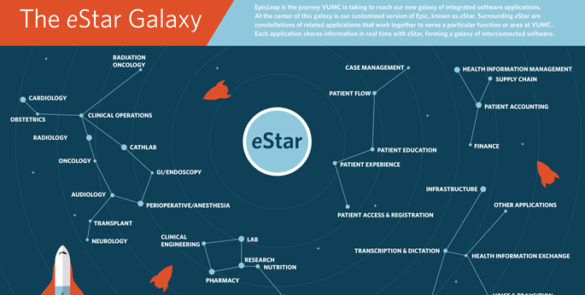by Madison Agee
When eStar goes live in the early morning hours of Nov. 2, the transition process should be largely invisible to the hundreds of patients who will be in the care of Vanderbilt University Medical Center (VUMC) at the time.
The detailed planning and extensive practice behind the actual cutover from VUMC’s existing software to eStar will result in a seamless experience — one that should have little impact on VUMC’s patients. ![]()
One aspect of this preparation is the involvement of the three patient and family advisory councils throughout the Medical Center. Starting earlier this year, the project team solicited feedback and guidance from the councils on how to best shape the patient experience and facilitate a smooth transition.
“The preparation of the project team has been incredible,” said Terrell Smith, VUMC’s director of Patient and Family Engagement. “Patients may notice more activity around the Medical Center in the days right after we officially launch the new software, but we don’t anticipate much of a bump in the road from their perspective.”
Once eStar is up and running, many patients will begin to see a difference, in a positive way. For one, it will better streamline their care at Vanderbilt. The entire range of health care team members — from physicians and nurses to check-in staff and accountants — will use the same system to enter and view information on a patient.
“Previously, we had multiple systems that worked together, but it wasn’t quite as easy or fast as eStar will be,” said Brian Carlson, director of patient experience. “From the time someone comes to the Emergency Department to their follow-up visit in one of our outpatient clinics, we’ll be able to care for them using one robust piece of software.”
In addition to various departments and areas sharing information internally within Vanderbilt, eStar allows VUMC to better share information on patients with external health care organizations and providers. eStar makes it possible for brand-new patients to Vanderbilt to have their current medication lists immediately visible within the system, all without them having to directly provide it. Likewise, patients who are referred to one of Vanderbilt’s specialists can have their detailed medical records, even the most extensive of files, electronically sent and available right away in eStar.
One of the most anticipated changes with the conversion to eStar will be that the new software allows Vanderbilt to combine different types of charges into a single statement. This means patients will receive one bill for all services performed at Vanderbilt.
“A single statement will be easier to read and help our patients better understand their financial responsibilities,” Smith elaborates.
The implementation of eStar also paves the way for two enhancements to the patient experience. The first is the requirement for substantially less paperwork they will be asked to complete, mostly because eStar sits at the center of a larger integrated system of applications, all of which share information in real time. And it is not only a reduction in paperwork that patients should see, but an overall reduction in requests for the same type of demographic or medical information.
The second enhancement that patients will start seeing in future months is the ability to schedule appointments, both online and through My Health at Vanderbilt, VUMC’s patient portal. Currently, there are a handful of departments where online self-scheduling is available, but the transition to eStar greatly expands this capability.
My Health at Vanderbilt will receive its own upgrade as part of the eStar implementation. Patients will see a new user interface, updated features, and additional functionality in the new version of the portal.
“In coming months, patients will be able to engage with their care in increasing fashion through My Health at Vanderbilt,” Carlson said.
Overall, the transition to eStar will help Vanderbilt more seamlessly deliver care and will strengthen the patient experience at VUMC. Jason Morgan, who chairs the Patient and Advisory Family Council for Vanderbilt University Hospital, said, “Following the implementation of eStar, the patient experience will align with the already superior level of clinical care patients receive at Vanderbilt today.”















